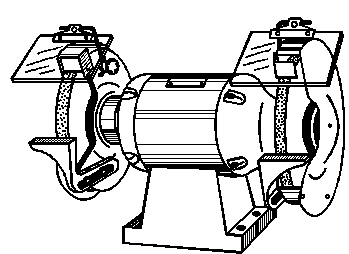- Acknowledgements
- Introduction
- Chapter 1: Measurement Tools, Layout & Job Planning
- Chapter 2: Basic Hand Tools
- Chapter 3: Filing & Sawing
- Chapter 4: Grinding, Reaming, Broaching & Lapping
- Chapter 5: Drills & Drilling Operations
- Chapter 6: Threads & Threading
- Chapter 7: Turning Operations
- Chapter 8: Milling Operations
- Chapter 9: Fastening Methods
- Chapter 10: Why Steel Hardens
- Chapter 11: Safety & Good Shop Practices
- Chapter 12: Other Shop Know-how
- Appendix I: Sharpening Steel Lathe Tools
- Appendix II: Surface Speed Table & Cutting Tool Selector Chart
- Appendix III: Decimal Equivalents of Fractional, Letter & Metric Drills
- Glossary
- Index
Chapter 4
Grinding, Reaming, Broaching & Lapping
In the republic of mediocrity, genius is dangerous.
—Robert G. Ingersoll
Introduction
Although grinding, reaming, broaching, and lapping remove a relatively small metal volume compared with turning and milling, they are important processes because they are often the last machining operation and determine final size and finish.
The basic versions of these processes are easy to learn and master. Steps to perform them are detailed here. Only the specialized grinding operations, center-less, cylindrical, internal, and surface grinding, that use dedicated machines, are beyond the range of most machine shops. Although this type grinding may be sent out to a grinding shop, it is often possible to purchase components that already have the ground surfaces needed and incorporate them into the project. This avoids the delay and inconvenience of sending out work. Examples of already-ground components are ready-to-machine ground flat stock, bearings, drill rod, drill blanks, reamer blanks and dowel pins.
Section I – Grinding
Grinding Mechanics
How does the grinding process remove material?
When work is brought into contact with a rotating grinding wheel, each abrasive grain on the wheel’s surface acts as a cutting tool and removes a tiny metal chip. When a grain becomes dull, the extra force between the wheel and the workpiece causes the dulled grain to break away due to a soft bond or friable grains. These fractures expose new sharp edges. Grinding wheels are the only self-sharpening cutting tools.
Grinding Processes
What are the main grinding processes and their applications?
- Offhand grinding applies size and shape to workpieces. The grinding wheel may be fixed and work hand-held or vice versa.
- Cutoff grinding works well for severing and slotting hard materials, particularly HSS stock, drill rod, dowel pins, and reamer blanks. Damaged end mills are often cut off with abrasive wheels in preparation for regrinding.
- Tool grinding involves the sharpening of drills, taps, milling machine and lathe cutters.
- Surface grinding applies a flat surface and brings the workpiece to the desired thickness and surface smoothness. It is the most common grinding operation and comprises over 75% of production grinding.
- Cylindrical grinding between centers brings parts to exact diameter, concentricity, and surface smoothness. Diameter tolerances in the tenths of thousandths of an inch are common. Precise tapers may also be applied. Although purpose-built machines perform cylindrical grinding in production, this process may be done in lathes with a grinding attachment (See Chapter 7 – Turning Operations).
- Centerless grinding produces the same results as cylindrical grinding, but is done when the work cannot be held between centers, usually because the work is too thin to resist bending. Also used for high production applications where it eliminates the need for centers.
- Internal grinding brings a bore to size and surface finish. Tapers can also be applied this way. A chuck holds the workpiece so it can be rotated as its bore is ground. This operation may also be performed on a lathe with a grinding attachment.
- Form grinding uses a shaped grinding wheel whose contour is transferred to the workpiece. Precision threads are often applied by form grinding.
- Snagging removes relatively large amounts of metal from billets, castings, and welds where tight tolerances or surface finish requirements are not important. This process is used in steel mills and foundries.
Table 4–1 shows where these processes are usually performed. Cylindrical, centerless, internal, and form grinding usually require dedicated, expensive machines, and skilled, full-time operators. This chapter focuses on the abrasive processes common in the general machine shop, the last three items in Table 4–1.
|
Process |
Where the Process Is Usually Used |
||
|
Production |
Tool Room |
General Machine Shop |
|
|
Cylindrical grinding between centers |
|
|
Note |
|
Centerless grinding |
|
|
|
|
Internal grinding |
|
|
Note |
|
Form grinding |
|
|
|
|
Snagging |
|
|
|
|
Surface grinding |
|
|
|
|
Cut off grinding |
|
|
|
|
Offhand grinding |
|
|
|
|
Tool grinding |
|
|
|
Note: Limited grinding, such as truing lathe centers, can be done in a lathe equipped with a tool post grinder.
Table 4–1. Where grinding processes are performed.
Bench & Pedestal Grinders
What are bench or pedestal grinders used for?
These grinders, Figure 4–1, perform offhand grinding to:
- Sharpen pointed tools like dividers, center punches, chisels, and scribers.
- Form and dress HSS lathe cutters.
- Grind new blades on screwdrivers.
- Remove burrs from drill shanks, and the ends of shortened fasteners.
- Apply a straight, angled, or rounded edge to metal stock.
- Remove mushrooms from chisel heads.

Figure 4–1. Bench grinder.

